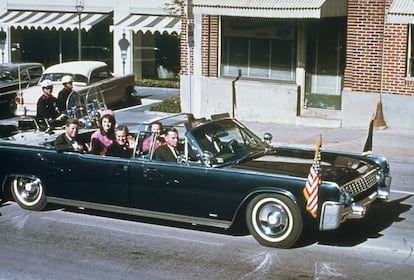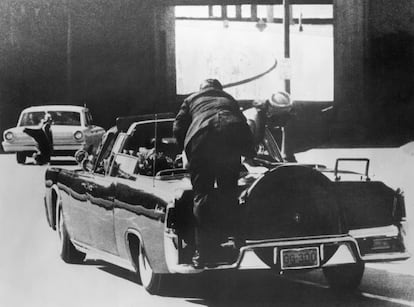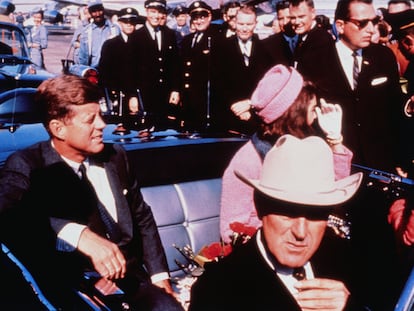Eyewitness to the JFK assassination discredits the ‘magic bullet theory’
Two documentaries revisit the infamous case that shook the United States 60 years ago


In the 60 years since the assassination of President John F. Kennedy in Dallas, speculation about the historic event has abounded. From documentaries to conspiracy theories, the assassination continues to fascinate and spark passionate debate. Recently, two new documentaries shed a little more light on the subject, and a witness named Paul Landis, one of the Secret Service agents protecting the president’s motorcade that day, has come forward to challenge the magic bullet theory established by the Warren Commission in 1964. According to Landis, the official account does not align with what he saw.
If social media had been around in 1963, facts, clues, suspicion and speculation would have fueled an eternal flame. But above the memories looms the legend, still hovering over the United States as if the events occurred just yesterday. The JFK case is still compelling today, especially as his nephew Bobby Kennedy has jumped into the 2024 presidential race, gaining a notable 24% in early polling. For the United States, successive generations of wealthy Kennedys are the closest thing the country has ever had to a dynasty — the Camelot dynasty.
The Warren Commission presented evidence (stored in the National Archives in Washington) supporting the single shooter conclusion. However, Landis challenges this by claiming to have found a second bullet in Kennedy’s limousine. This hypothesis raises doubts about the sole responsibility of Lee Harvey Oswald, who was arrested for the murder and killed two days later by Jack Ruby while in custody at a Dallas police station.
The vast majority (97%) of the case-related documentation is publicly accessible. The National Archives’ research service estimated 11 months ago that only 515 documents remain fully classified, with an additional 2,545 partially classified. The most recent decision in this regard is a memorandum from President Joe Biden, dated December 15, 2022, in which he states that “from the date of this memorandum until May 1, 2023, relevant agencies and NARA [National Archives and Records Administration] will jointly review the remaining material in the archives […] in order to maximize transparency by disclosing all information in records concerning the assassination, except when the strongest possible reasons counsel otherwise. Any information that agencies propose for continued deferral of public disclosure beyond June 30, 2023, will be limited to the absolute minimum under the legal standard.”
Classified documents
The 3% of documentation that remains classified to protect against an identifiable harm to the military defense, intelligence operations, law enforcement, or the conduct of foreign relations continues to capture the imagination of many. And who better than an eyewitness like Paul Landis to challenge the official story? But why it took him 60 years to come forward is another question. In interviews leading up to the October release of his memoir, The Final Witness, Landis says he heard three gunshots and then saw the president collapse in the back seat of the limousine. Three shots, not two, as he declared in a written statement a week after the assassination.
Landis’ story provides hope to those who contend that there were multiple shooters in Dallas on that fateful day. While he unequivocally dismisses conspiracy theories, he challenges the primary finding of the Warren Commission, which posits that one of the bullets struck the president from behind, exiting through the front of his throat, and then striking Governor Connally, inflicting serious wounds to his back, chest, wrist and thigh. The notion that a single bullet could cause such extensive damage seemed implausible, leading skeptics to dub it the “magic bullet theory.”
The Warren Commission reached that conclusion in part because a bullet was found on a gurney believed to have transported Connally to Parkland Memorial Hospital. They assumed it had been removed during first aid. However, Landis, who was never interviewed by the Warren Commission, claimed otherwise. Landis says he found the bullet in the limousine, lodged in the back of the back seat where Kennedy was sitting. He grabbed the bullet as evidence, worried that it might disappear in all the confusion. Landis then placed it on Kennedy’s gurney at the hospital, and somehow, it ended up with Connally.

Landis always believed that Oswald acted alone, but expressed doubts about his conviction in a September interview with The New York Times. The investigation concluded that the bullets were fired from a Mannlicher-Carcano C2766 rifle, which was discovered on the sixth floor of the Texas School Book Depository (now a nondescript government building). If Governor Connally was indeed struck by another bullet, Landis says it seems implausible that Oswald would have had time to reload his rifle so quickly. In other words, a second shooter.
The documentary JFK: What the Doctors Saw puts the post-mortem medical reports in the spotlight, capturing the accounts of the doctors who attended to President Kennedy in the Parkland Memorial Hospital emergency room. The New York Times review of this documentary drips with sarcasm: “While some documentaries feel like rundowns of a Wikipedia page, What the Doctors Saw more closely resembles a Q. and A. session with Siri. What did the staff observe? An entrance wound on Kennedy’s throat. What does that suggest? A bullet entered from the front. Why is that significant? It contradicts the findings of the Warren Commission.” The 90-minute documentary clinically marches through the inconsistencies between the injuries that the doctors observed at the Dallas hospital and the official autopsy conducted at the Walter Reed National Military Medical Center in Bethesda, Maryland.
The three-part documentary JFK: One Day in America by National Geographic delves into the events of November 22, 1963. The Wall Street Journal review applauds the production for skillfully weaving previously unreleased content with more familiar material. The documentary includes private film footage and lesser-known clips offering unique perspectives like Jack Ruby casually interacting with the press and police at the Dallas police station the night before he killed Oswald. We also watch a grieving Jackie Kennedy waiting for her husband’s coffin to arrive before making the journey back to Washington. These intimate moments evoke a sense of closeness and deep sorrow. The documentary introduces new material, including testimonies from two Secret Service agents: Clint Hill and Paul Landis, who refrained from commenting on his bullet theory in the documentary.
There has been plenty of speculation about Jack Ruby, the underworld small-fry and strip club owner who killed Oswald in front of the whole world. How was Ruby able to roam around the Dallas police station so freely carrying a pistol? Two murders within 48 hours? In 1964, the Warren Commission concluded that Ruby acted alone, seeking revenge for Kennedy’s death. A lone gunman, just like Oswald. Nevertheless, there are those who suspect that Oswald’s death was the conclusive element of a larger conspiracy to assassinate Kennedy. Five years later, Senator Robert F. Kennedy was assassinated at a campaign rally in a Los Angeles hotel, another grim milestone in the country’s history of political violence.
Sign up for our weekly newsletter to get more English-language news coverage from EL PAÍS USA Edition








































